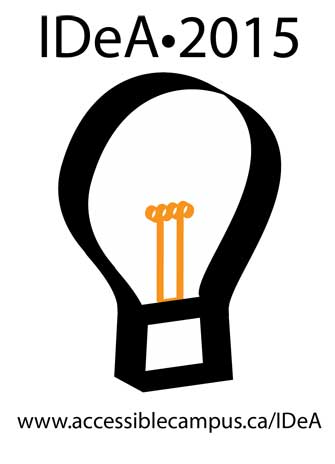 Glasses to aid individuals with hearing impairment by displaying spoken words to users, an app that helps people with tremors use their smart phones with ease and a phys-ed curriculum that exposes elementary students to para-sports and professional para-sport athletes are among finalists in the Council of Ontario Universities’ annual Innovative Designs for Accessibility (IDeA) student competition taking place today in Toronto.
Glasses to aid individuals with hearing impairment by displaying spoken words to users, an app that helps people with tremors use their smart phones with ease and a phys-ed curriculum that exposes elementary students to para-sports and professional para-sport athletes are among finalists in the Council of Ontario Universities’ annual Innovative Designs for Accessibility (IDeA) student competition taking place today in Toronto.
A team of six students from York University is among the 10 finalists in 2015 IDeA student competition, which engages students in an experiential education initiative that has the student teams think about challenges faced by people with disabilities and develop solutions to break down barriers whenever they come across them.
The team from the Lassonde School of Engineering made the top 10 for their concept for eyeglasses for individuals with a hearing impairment that use microphones and speech recognition software to display words spoken to the user. The team members are: Toni Kunic, Jonathan Lebon, Yantesh Dhir, Vahe Khachikyan, Bilal Raza and Dev Vishnu Dutta.
The Lassonde team along with the other finalist teams from five Ontario universities will showcase their inventions at the People in Motion exhibition at the Queen Elizabeth Building at Toronto’s Exhibition Place on today (May 29) at 2 pm. The top three teams will be announced today at 2:30pm.
“An important goal for universities is to get students to think about challenges faced by people with disabilities so that they will carry that awareness into the world and help to break down barriers whenever they come across them,” says COU President and CEO Bonnie M. Patterson.
All 21 Ontario universities participated in the contest, which is supported through the Ontario government’s EnAbling Change program and partners at the Accessibility Directorate of Ontario in the Ministry of Economic Development, Trade and Employment.
The other IDeAs include:
- Devices to help people get up or down from a chair that are aesthetically pleasing for use in the home – Quayce Thomas and Brendan O’Brien, Carleton University.
- A study on how communal city gardens can help people with disabilities develop life skills – Zoe Wimmer, University of Guelph.
- A garden planter and hand-washing station for patients using the Healing Garden at the Children’s Hospital of Eastern Ontario – Jin Kyung Kim and Dayna Conway, Carleton University.
- A multi-lingual campus poster campaign designed to help combat the stigma surrounding mental health – Cassie Liviero, Ingie Metwally and Naznin Alam, McMaster University.
- A brace for the arm of a person with Huntington’s Disease that uses sensors to minimize involuntary movements – Caulan Rupke, Siddharth Pai, Tianshi Cao and Jiali Yan, University of Toronto.
- An app that promotes healthy active living by checking in to make sure users are meeting the goals they’ve shared with their social network – Quayce Thomas and Brendan O’Brien, Carleton University.
- A mobile app designed to help people who have tremors use various applications on their smart phones with greater ease – Mark Goldberg, University of Guelph.
- A cargo trailer that attaches to the back of a wheelchair that allows users to independently transport sledge hockey equipment – Liam D’Souza, Angela Chen, Mazhar Jabakhanji and Adithya Prashant, University of Toronto.
- Curriculum that exposes elementary school students to para-sports by allowing them to play with professional para-sport athletes – Kate Jones and Miguel Botero, University of Ottawa.
The winner and two runners-up will receive prizes of $1,500, $1,000 and $500 respectively. A bonus prize of $1,500 will be awarded to the IDeA that best addresses a barrier in para-sport and active living.


